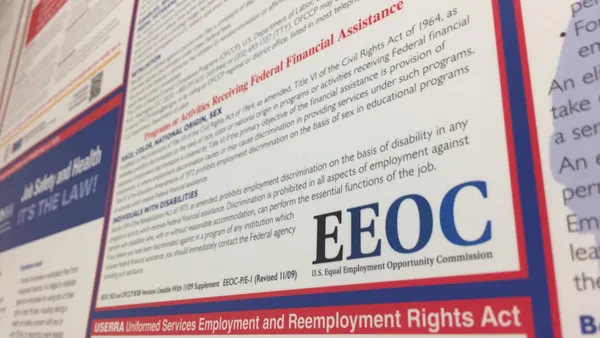Dive Brief:
- A signed independent contractor acknowledgement form wasn't enough for an employer to overcome a delivery driver's claims that he was in fact an employee, a federal district court held (Nemo v. RR Donnelley Logistics Svcs., No. 2:17-cv-02130 (N.D. Ala. Feb. 8, 2019)).
- Steve Nemo, after being fired by RR Donnelley Logistics Services, alleged in a lawsuit that the company terminated him because of his race, gender and age, in violation of Title VII of the Civil Rights Act of 1964 and the Age Discrimination in Employment Act (ADEA).
- The company asked the court to dismiss his claims, as those laws apply only to employees and Nemo had agreed to independent contractor status, accepting responsibilities for his fuel, equipment and tool expenses. Nemo, however, provided evidence that he was assigned delivery routes and had to use specific software on his phone. The agreement is relevant, the court said, but only tells part of the story. Under the controlling 11th Circuit's Title VII "economic realities" test, a reasonable jury could find that Nemo was an employee, the court said, refusing to dismiss his claims.
Dive Insight:
As this case illustrates, independent contractor agreements can be relevant, but they're not everything. Personal preference — whether a business' or a worker's — cannot dictate classification. Instead, employers must use relevant tests to determine whether to classify a worker as a contractor or an employee.
Unfortunately for employers, there is no single legal definition for determining whether individuals are employees or independent contractors. The U.S. Department of Labor (DOL) maintains one test for the Fair Labor Standards Act, while federal appellate courts have devised their own under that law.
Employers must also consider applicable state and local laws. California, for example, made headlines in 2018 when the top state court changed its longstanding test, making it harder for employers to classify workers as independent contractors. The court held that there is a presumption that workers are employees under the wage orders adopted by California's Industrial Welfare Commission. To classify someone as an independent contractor, the court said, businesses must show that the worker (a) is free from the control and direction of the employer; (b) performs work that is outside the hirer's core business; and (c) customarily engages in "an independently established trade, occupation or business." The court took its “ABC” test from a standard used in 22 other states, although its interpretation was more stringent.
Additional confusion stems from various tests adopted for various laws. The National Labor Relations Board, for example, maintains a separate test for coverage under the National Labor Relations Act. And as the Nemo court noted, some classification issues remain unresolved. The 11th Circuit has not instructed district courts to apply its test in ADEA cases, the lower court said; "Consequently, in ADEA cases, district courts must adapt other federal law tests to evaluate the nature of parties' working relationship. Those tests include the common-law agency test, the [FLSA] economic realities test, and a blended or hybrid approach that combines the common-law agency test with 'a consideration of the ‘economic realities' of the hired party's dependence on the hiring party.'"
Until employers receive further clarification, they'll need to weigh all applicable laws and judicial tests.











